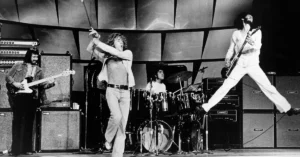National Health: The Canterbury Scene’s Chamber of Complexity
National Health. A New Chapter in Canterbury’s Evolution
National Health formed in 1975 as the next logical step in the intricate lineage of the Canterbury Scene, a movement known for its fusion of jazz, progressive rock, and British eccentricity. Rising from the ashes of Hatfield and the North, the group was conceived as a supergroup of sorts—uniting some of the most musically accomplished figures from earlier bands such as Gong, Hatfield, Gilgamesh, and Delivery.
Founding Members:
- Dave Stewart (keyboards, ex-Hatfield and the North, Egg)
- Alan Gowen (keyboards, ex-Gilgamesh)
- Phil Miller (guitar, ex-Matching Mole, Hatfield)
- Bill Bruford (drums, ex-Yes, King Crimson – briefly involved)
- Mont Campbell (bass, ex-Egg – early demos)
Though many musicians came and went in the band’s early days, the core identity crystallized around Stewart, Miller, and later Pip Pyle (drums) and John Greaves (bass, ex-Henry Cow). The group leaned into the instrumental complexity that had become the hallmark of Canterbury fusion.
Musical Vision: Jazz-Rock with a Chamber Ensemble’s Precision
National Health distinguished themselves by fully embracing long-form composition, intricate instrumental dialogue, and a classical sense of form and development—creating music that felt as much like modern chamber music as it did rock or jazz.
Hallmarks of Their Sound:
- Layered keyboard textures (often Moog, Fender Rhodes, Hammond)
- Extended instrumental passages
- Unusual time signatures and polyrhythms
- Subtle British humor and surreal song titles
- Minimal vocals, with the focus squarely on instrumental storytelling
Their music was less psychedelic than Gong’s, less humorous than Hatfield’s, and more refined and disciplined, yet never dry or academic.
Debut Album: National Health (1978)
After years of lineup changes and live performances, National Health released their self-titled debut in 1978—ironically, as the popularity of punk rock was exploding in the UK.
National Health. Highlights:
- “Tenemos Roads” – A 14-minute suite with occasional vocals (by Amanda Parsons) and flowing, symphonic development.
- “Brujo” – Complex rhythmic games and fusion fury.
- “Elephants” – A bizarre but tightly composed track with a witty sensibility.
- “Borogoves (Excerpt)” – Another display of contrapuntal prowess.
The album was both technically dazzling and emotionally rich, making it one of the most accomplished Canterbury records ever made. Despite its brilliance, it was critically respected but commercially overlooked, released at a time when long-form music was falling out of favor.
Of Queues and Cures (1978): A Peak of Sophistication
Their second album, released the same year, is often cited as their masterpiece.
Key Tracks:
- “The Bryden Two-Step (For Amphibians), Part One & Two” – Quirky yet beautifully constructed, combining playfulness with structural complexity.
- “Dreams Wide Awake” – Featuring Phil Miller’s expressive guitar work and elaborate harmonic structures.
- “Binoculars” – The rare vocal track with John Greaves, offering an introspective counterpoint to the rest of the album.
With fewer vocals and even more ambitious arrangements, Of Queues and Cures is a crown jewel of the Canterbury scene, showcasing the genre at its most musically advanced.
A Farewell in Spirit: D.S. Al Coda (1982)
After the untimely death of Alan Gowen from leukemia in 1981, the remaining members reunited to record D.S. Al Coda, a posthumous tribute album made up of Gowen’s compositions.
It’s an elegant and emotional farewell, combining studio precision with heartfelt homage. While not as celebrated as their first two albums, it remains a fitting close to the band’s creative journey.
National Health. Legacy and Influence
National Health’s influence continues to resonate in the worlds of progressive rock, avant-garde jazz, and modern fusion. While they never achieved mainstream success, their legacy includes:
- Pushing the boundaries of instrumental rock
- Inspiring bands like The Muffins, Thinking Plague, and Änglagård
- Cementing the Canterbury Scene’s reputation for intellectual and musical depth
Unlike their peers, National Health eschewed vocals and commercial tropes in favor of pure musical exploration. Their legacy is one of uncompromising artistic integrity, and their albums remain essential listening for serious prog fans.
Final Thoughts: High Art with a Playful Heart
National Health represented the pinnacle of Canterbury musicianship—technical, cerebral, but with a deep sense of joy in the act of creation. They fused rock’s electric energy, jazz’s rhythmic agility, and classical music’s structural sophistication into something truly timeless.
They may have come at the wrong time commercially, but in the annals of progressive music, they were right on time.





